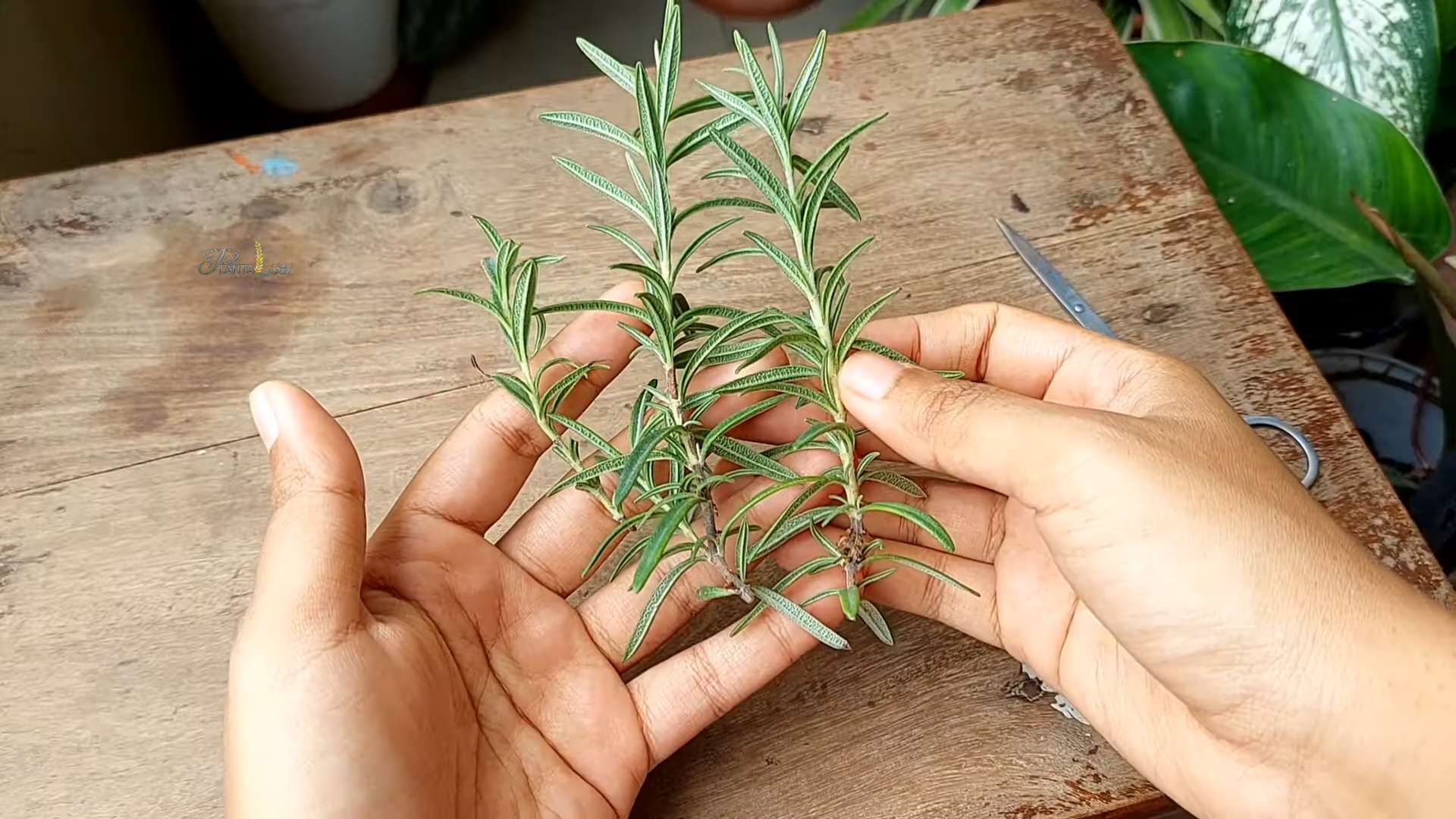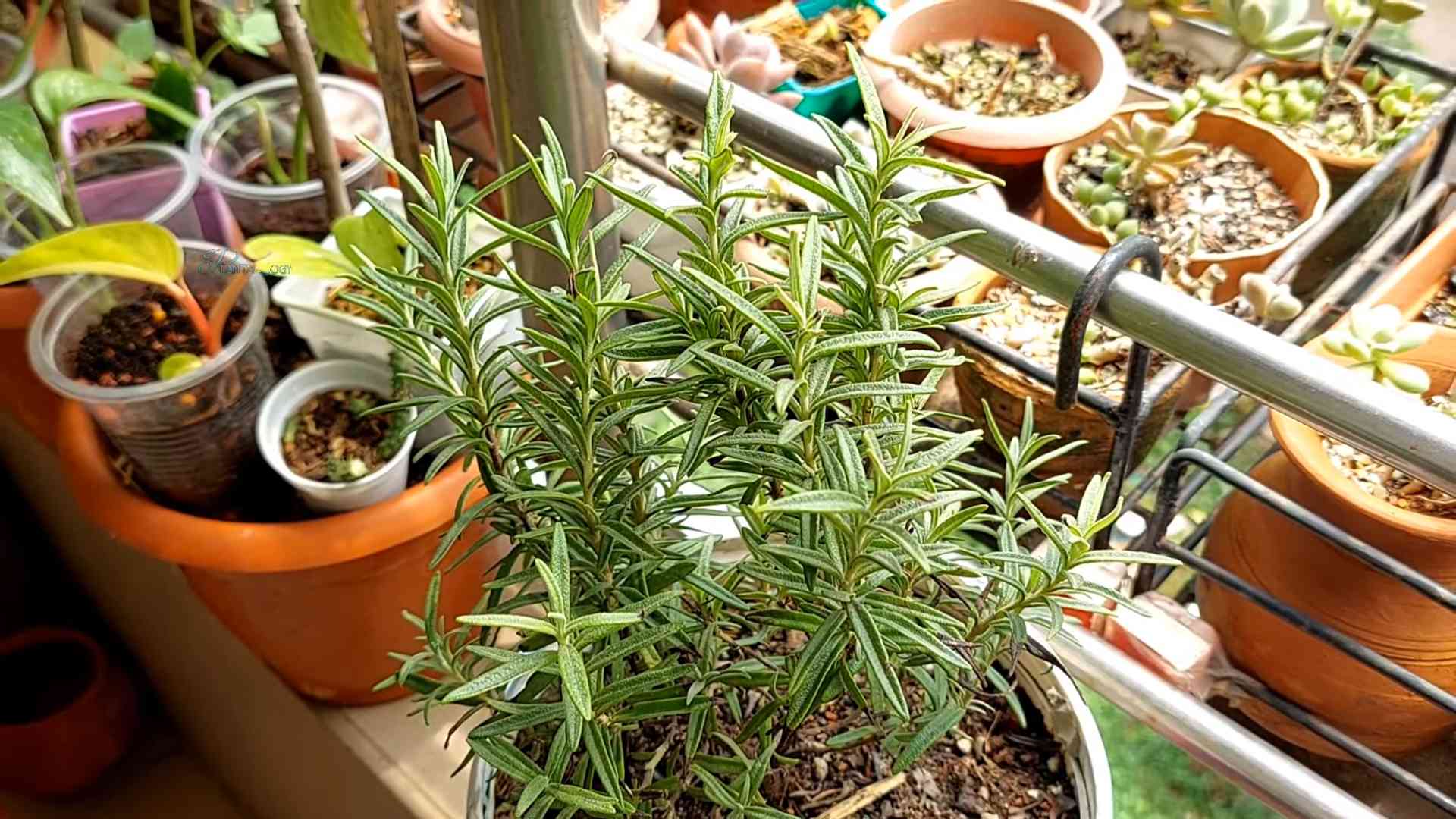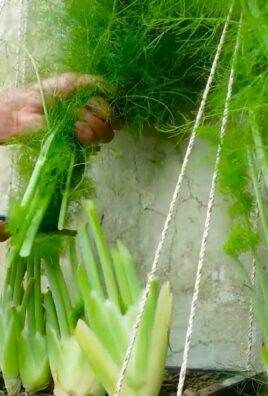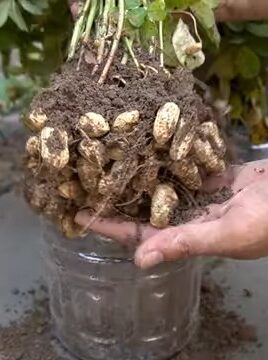Grow Rosemary at Home and unlock a world of fragrant possibilities right outside your door! Have you ever dreamed of snipping fresh herbs for your culinary creations, or perhaps crafting your own aromatic bath products? Well, dream no more! This DIY guide is your passport to cultivating this versatile herb, even if you think you have a “brown thumb.”
Rosemary, with its needle-like leaves and woody aroma, boasts a rich history. Revered since ancient times for its medicinal and symbolic properties, rosemary was believed to enhance memory and was often used in wedding ceremonies and funerals. From ancient Greece to modern kitchens, rosemary has held a special place in our lives.
But why should you learn to grow rosemary at home? In today’s world, where we’re increasingly conscious of what we consume and where it comes from, having your own herb garden is a fantastic way to ensure freshness and quality. Plus, store-bought rosemary can be expensive and often wilts quickly. With a few simple tricks and hacks, you can have a thriving rosemary plant providing you with fresh herbs year-round. I’m here to show you how to easily grow rosemary at home, saving you money and adding a touch of Mediterranean charm to your space. Let’s get started!

Grow Your Own Rosemary: A Beginner’s Guide
Hey there, fellow plant enthusiasts! I’m so excited to share my experience with growing rosemary at home. It’s surprisingly easy, incredibly rewarding, and having fresh rosemary on hand for cooking is a total game-changer. Plus, the aroma is just divine! I’m going to walk you through everything you need to know, from choosing the right rosemary variety to harvesting your fragrant bounty. Let’s get started!
Choosing Your Rosemary Variety
Before we dive into the nitty-gritty, let’s talk rosemary varieties. Did you know there are different types? I sure didn’t when I started! Here’s a quick rundown:
* Upright Rosemary: These are the classic, bushy types you probably picture when you think of rosemary. They grow tall and are perfect for hedges or adding vertical interest to your garden. Common varieties include ‘Tuscan Blue’ and ‘Blue Spires’.
* Creeping Rosemary: As the name suggests, these varieties spread horizontally, making them ideal for ground cover or cascading over walls. ‘Prostratus’ is a popular creeping rosemary.
* Dwarf Rosemary: These are smaller, more compact varieties that are perfect for containers or small gardens. ‘Blue Boy’ is a well-known dwarf rosemary.
I personally prefer upright rosemary because I love the look of a bushy plant, but creeping rosemary is fantastic for adding texture to your landscape. Consider your space and desired look when making your choice.
Getting Started: Propagation Methods
There are a few ways to get your rosemary journey started. You can buy a starter plant from a nursery, propagate from cuttings, or even try growing from seeds (though this is the trickiest). I’ve had the most success with cuttings, so that’s what I’ll focus on.
* From Cuttings: This is my preferred method. It’s relatively easy and you get a clone of the parent plant, ensuring you get the variety you want.
* From Seeds: This is the most challenging method, as rosemary seeds can be slow and difficult to germinate.
* From Starter Plants: Buying a small rosemary plant from a nursery is the easiest way to get started, but you’ll need to repot it into a larger container or plant it in your garden.
Taking Rosemary Cuttings: Step-by-Step
Okay, let’s get our hands dirty! Here’s how I take rosemary cuttings:
1. Gather Your Supplies: You’ll need a healthy rosemary plant (preferably one you already have!), sharp pruning shears or scissors, rooting hormone (optional but recommended), small pots or containers, and well-draining potting mix. I like to use a mix of perlite, vermiculite, and peat moss.
2. Select Your Cuttings: Look for healthy, non-flowering stems that are about 4-6 inches long. Avoid stems that are too woody or too soft.
3. Make the Cut: Using your sharp pruning shears, make a clean cut just below a leaf node (the point where a leaf grows from the stem).
4. Prepare the Cutting: Remove the leaves from the bottom inch or two of the stem. This is where the roots will grow.
5. Apply Rooting Hormone (Optional): Dip the cut end of the stem into rooting hormone powder or liquid. This will help stimulate root growth. I find it makes a big difference, but you can still have success without it.
6. Plant the Cutting: Fill your small pot with well-draining potting mix. Make a small hole in the center of the soil and gently insert the cutting.
7. Water and Cover: Water the cutting thoroughly and then cover the pot with a plastic bag or humidity dome. This will help create a humid environment that encourages root growth.
8. Provide Light and Warmth: Place the cutting in a warm, bright location, but avoid direct sunlight. A windowsill or under grow lights works well.
9. Monitor and Water: Check the cutting regularly to make sure the soil stays moist but not soggy. Water as needed.
10. Wait for Roots: It can take several weeks for roots to develop. You’ll know the cutting has rooted when you see new growth or when you gently tug on the stem and feel resistance.
11. Transplant: Once the cutting has developed a good root system, you can transplant it into a larger pot or into your garden.
Caring for Your Rosemary Plant
Now that you have your rosemary plant, it’s time to learn how to care for it. Rosemary is relatively low-maintenance, but there are a few key things to keep in mind.
* Sunlight: Rosemary loves sunshine! Aim for at least 6-8 hours of direct sunlight per day. If you’re growing rosemary indoors, place it near a sunny window or use grow lights.
* Watering: Rosemary is drought-tolerant, so it’s important not to overwater it. Allow the soil to dry out completely between waterings. When you do water, water deeply, until water drains out of the bottom of the pot.
* Soil: Rosemary prefers well-draining soil. A sandy or loamy soil is ideal. Avoid heavy clay soils, as they can retain too much moisture and lead to root rot.
* Fertilizing: Rosemary doesn’t need a lot of fertilizer. You can fertilize it once or twice a year with a balanced fertilizer. I like to use a slow-release fertilizer in the spring.
* Pruning: Pruning is important for keeping your rosemary plant healthy and productive. Prune regularly to remove dead or diseased branches and to encourage bushier growth. You can also prune to shape the plant.
* Overwintering: If you live in a cold climate, you’ll need to protect your rosemary plant from frost. You can either bring it indoors or cover it with a frost blanket. Rosemary is hardy to about 30 degrees Fahrenheit.
Troubleshooting Common Rosemary Problems
Even with the best care, you might encounter some problems with your rosemary plant. Here are a few common issues and how to address them:
* Root Rot: This is caused by overwatering. The leaves will turn yellow or brown and the plant may wilt. To prevent root rot, make sure your rosemary plant is planted in well-draining soil and avoid overwatering. If you suspect root rot, you can try repotting the plant in fresh soil.
* Powdery Mildew: This is a fungal disease that causes a white, powdery coating on the leaves. To prevent powdery mildew, provide good air circulation and avoid overhead watering. If you see powdery mildew, you can treat it with a fungicide.
* Spider Mites: These tiny pests can suck the sap from rosemary leaves, causing them to turn yellow or brown. To control spider mites, you can spray the plant with insecticidal soap or neem oil.
* Yellowing Leaves: Yellowing leaves can be caused by a number of factors, including overwatering, underwatering, nutrient deficiencies, or pests. Check the soil moisture and look for signs of pests. If the soil is too wet, allow it to dry out completely before watering again. If the soil is too dry, water deeply. You can also try fertilizing the plant with a balanced fertilizer.
Harvesting Your Rosemary
The best part of growing rosemary is harvesting it! You can start harvesting rosemary as soon as the plant is established, usually after a few months.
* When to Harvest: You can harvest rosemary at any time of year, but the flavor is most intense in the spring and summer.
* How to Harvest: Use sharp pruning shears or scissors to cut off stems. Avoid cutting off more than one-third of the plant at a time.
* Using Fresh Rosemary: Fresh rosemary can be used in a variety of dishes, including roasted meats, vegetables, soups, and sauces. You can also use it to make rosemary-infused oil or vinegar.
* Drying Rosemary: To dry rosemary, tie the stems together and hang them upside down in a cool, dry place. Once the leaves are dry, you can crumble them and store them in an airtight container.
Using Rosemary in the Kitchen
Okay, now for the fun part: cooking with your homegrown rosemary! I use rosemary in so many dishes. Here are a few of my favorites:
* Roasted Rosemary Potatoes: Toss potatoes with olive oil, rosemary, salt, and pepper, and roast until golden brown.
* Rosemary Chicken: Rub chicken with olive oil, rosemary, salt, and pepper, and roast or grill.
* Rosemary Bread: Add fresh rosemary to your favorite bread recipe for a fragrant and flavorful loaf.
* Rosemary Infused Olive Oil: Add a few sprigs of rosemary to a bottle of olive oil and let it infuse for a few weeks. Use the oil for cooking or drizzling over salads.
Rosemary Beyond the Kitchen
Rosemary isn’t just for cooking! It also has a number of other uses.

Conclusion
So, there you have it! Growing rosemary at home is not only achievable, but it’s also incredibly rewarding. Forget those wilted, overpriced sprigs from the grocery store. Imagine stepping out your back door or reaching for a pot on your windowsill and snipping fresh, fragrant rosemary whenever you need it. The flavor difference alone is enough to convince anyone to give this a try.
This DIY approach to fresh herbs offers a multitude of benefits. You’ll save money, reduce waste from plastic packaging, and have access to a superior product. Plus, nurturing a plant from a cutting or seedling is a deeply satisfying experience. It connects you to the natural world and provides a sense of accomplishment.
But the advantages don’t stop there. Think about the possibilities! You can experiment with different varieties of rosemary, each with its own unique aroma and flavor profile. Try growing ‘Blue Boy’ for its compact size and intense flavor, or ‘Golden Rain’ for its beautiful variegated foliage. You can even train your rosemary plant into a topiary for a decorative touch.
Consider using your homegrown rosemary in a variety of culinary creations. Infuse olive oil with its distinctive flavor, add it to roasted vegetables for an earthy depth, or use it to season grilled meats and poultry. Rosemary is also a wonderful addition to baked goods, adding a savory note to breads, biscuits, and even desserts.
Beyond the kitchen, rosemary has a long history of medicinal and aromatic uses. Its scent is known to improve memory and concentration, making it a perfect addition to your home office or study space. You can also use rosemary to create homemade beauty products, such as hair rinses and skin tonics.
We’ve covered the basics of propagation, planting, and care, but remember that gardening is a journey of learning and experimentation. Don’t be afraid to try new things and adapt your approach based on your specific environment and growing conditions.
Ready to embark on your own rosemary-growing adventure? We wholeheartedly encourage you to give it a try. Start small, be patient, and don’t be discouraged by setbacks. With a little care and attention, you’ll be enjoying the benefits of fresh, homegrown rosemary in no time.
And most importantly, we want to hear about your experiences! Share your successes, your challenges, and your tips for growing rosemary at home in the comments below. Let’s create a community of rosemary enthusiasts and learn from each other. What variety are you most excited to grow? What recipes are you planning to create with your fresh rosemary? We can’t wait to hear from you! This is the best way to ensure you always have fresh **rosemary** on hand.
Frequently Asked Questions (FAQ)
How long does it take to grow rosemary from a cutting?
Rooting rosemary cuttings typically takes anywhere from 4 to 8 weeks, depending on factors like humidity, temperature, and the health of the cutting. You’ll know the cutting has rooted when you see new growth emerging from the top or when you gently tug on the cutting and feel resistance. Be patient and consistent with watering during this period.
What kind of soil is best for rosemary?
Rosemary thrives in well-draining soil that is slightly acidic to neutral (pH 6.0-7.0). A sandy loam is ideal, as it allows for good drainage and aeration. Avoid heavy clay soils, which can retain too much moisture and lead to root rot. You can amend clay soils with compost, perlite, or sand to improve drainage. A good potting mix for rosemary would be a blend of potting soil, perlite, and vermiculite.
How much sunlight does rosemary need?
Rosemary needs at least 6 to 8 hours of direct sunlight per day to thrive. If you’re growing rosemary indoors, place it near a sunny window, preferably a south-facing one. If you don’t have enough natural light, you can supplement with a grow light. Insufficient sunlight can lead to leggy growth and reduced flavor.
How often should I water rosemary?
Rosemary is drought-tolerant once established, so it’s important not to overwater it. Water thoroughly when the top inch of soil feels dry to the touch. Allow the soil to dry out slightly between waterings. Overwatering can lead to root rot, which is a common problem with rosemary. In the winter, reduce watering frequency even further.
Can I grow rosemary indoors?
Yes, rosemary can be successfully grown indoors, provided you meet its needs for sunlight, well-draining soil, and proper watering. Choose a pot with drainage holes and use a well-draining potting mix. Place the pot in a sunny location or supplement with a grow light. Be sure to monitor the plant for pests and diseases, and provide adequate ventilation.
What are some common pests and diseases that affect rosemary?
Rosemary is generally resistant to pests and diseases, but it can be susceptible to spider mites, aphids, and powdery mildew. Spider mites are tiny pests that suck the sap from leaves, causing them to become speckled and discolored. Aphids are small, soft-bodied insects that can also damage leaves and stems. Powdery mildew is a fungal disease that appears as a white, powdery coating on the leaves. To prevent these problems, provide good air circulation, avoid overwatering, and inspect your plants regularly. If you notice any pests or diseases, treat them promptly with insecticidal soap or neem oil.
How do I prune rosemary?
Pruning rosemary is important for maintaining its shape, promoting bushier growth, and preventing it from becoming leggy. Prune rosemary in the spring or summer, after it has finished flowering. Use sharp, clean pruning shears to remove dead, damaged, or crossing branches. You can also trim back the tips of the branches to encourage new growth. Avoid pruning more than one-third of the plant at a time.
Can I propagate rosemary from seeds?
While it is possible to grow rosemary from seeds, it is a much slower and less reliable method than propagating from cuttings. Rosemary seeds can be difficult to germinate, and the resulting plants may not be true to type. If you do choose to grow rosemary from seeds, start them indoors in the early spring, using a seed-starting mix. Keep the soil moist and warm, and provide plenty of light.
How do I harvest rosemary?
You can harvest rosemary at any time of year, but the flavor is most intense in the spring and summer. To harvest, simply snip off sprigs of rosemary with sharp scissors or pruning shears. Avoid cutting back more than one-third of the plant at a time. You can use fresh rosemary immediately, or you can dry it for later use.
How do I dry rosemary?
There are several ways to dry rosemary. One method is to tie the sprigs together and hang them upside down in a cool, dry, and well-ventilated place. Another method is to spread the sprigs on a baking sheet and dry them in a low oven (170°F or 77°C) for several hours. You can also use a dehydrator to dry rosemary. Once the rosemary is completely dry, store it in an airtight container in a cool, dark place.
What are some creative ways to use homegrown rosemary?
Beyond culinary uses, homegrown rosemary can be used in a variety of creative ways. Infuse olive oil with rosemary for a flavorful dipping oil or salad dressing. Add rosemary to bathwater for a relaxing and aromatic soak. Use rosemary to create homemade potpourri or sachets. You can even use rosemary to make natural cleaning products. The possibilities are endless!





Leave a Comment